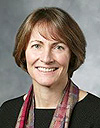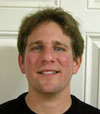|
Welcome to this edition of Perspectives, the e-newsletter of the
Stanford course Perspectives in Assistive Technology.
What
is the course? - Perspectives in Assistive Technology is a
Winter Quarter course at Stanford that explores issues surrounding the design,
development, and use of assistive technology for people with disabilities and
seniors. More information can be found on the course
website.
Invitation to attend - You are invited to attend
all class lectures. They will be held in the
Main Quad, Building 370, Classroom 370 on
Tuesday and Thursday afternoons at 4:15 to 5:30pm and are free and open
to the public.
Next class session - Thursday, February 17th
at 4:15pm:
|
 
|
Gait, CP, and
FES
Jessica Rose, PhD 1 & Adam Sheppard, BS, MM, MA 2
1 Associate Professor, Department
of Orthopaedic Surgery
Stanford University School of Medicine
1 Director,
Motion & Gait Analysis Lab
Lucile Packard Children's
Hospital
2 Bioengineer, Motion & Gait Analysis Lab
Lucile Packard
Children's Hospital |
Abstract: Clinical
gait analysis is now standard-of-care for diagnosis and treatment of walking
disorders in children with cerebral palsy and other neuromuscular conditions.
Gait analysis includes 3D motion capture of kinematics (joint motion) and
kinetics (joint forces), as well as electromyography (EMG) for muscle activity
during gait. New computer simulations are used to clarify the musculoskeletal
components of gait abnormalities. The kinematic, kinetic and EMG data are
interpreted along with energy cost of walking and with postural balance
measures to determine risk of falls and to avoid unpredictable surgical
outcomes. The gait analysis is reviewed to determine an optimal treatment plan
by a multidisciplinary team of clinicians that includes physical therapists,
orthopaedic surgeons, physiologists, engineers, and orthotists. This lecture
will introduce students to clinical Gait Analysis and to a new, developing
assistive technology that utilizes functional electrical stimulation (FES) for
artificial walking: FES-assisted gait for children with cerebral
palsy. Biosketches:
|
Dr. Jessica
Rose's research focuses on the neuromuscular and musculoskeletal mechanisms
underlying gait abnormalities in children with cerebral palsy (CP) and other
pediatric orthopaedic conditions. As director of the Motion & Gait Analysis
Lab at Lucile Packard Children's Hospital, her research has focused on the
energy cost of walking, muscle pathology, selective motor control, postural
balance, and motor-unit firing in CP.
Stanford Community
Academic Research Profile |
Adam Sheppard is
currently working on applications of artificial walking technologies with a
national research network that investigates the use of functional electrical
stimulation (FES) to aid in the rehabilitation of walking disorders in children
with cerebral palsy. He develops electrical stimulation sequences for muscle
activation, integrating data from microelectromechanical systems (MEMS) sensors
to provide real-time motion feedback and control for FES-assisted
gait. |
        
        
       
Do
you have a question or comment? - David L. Jaffe, MS, the
course organizer, can be reached by email or at 650/892-4464.
|
|